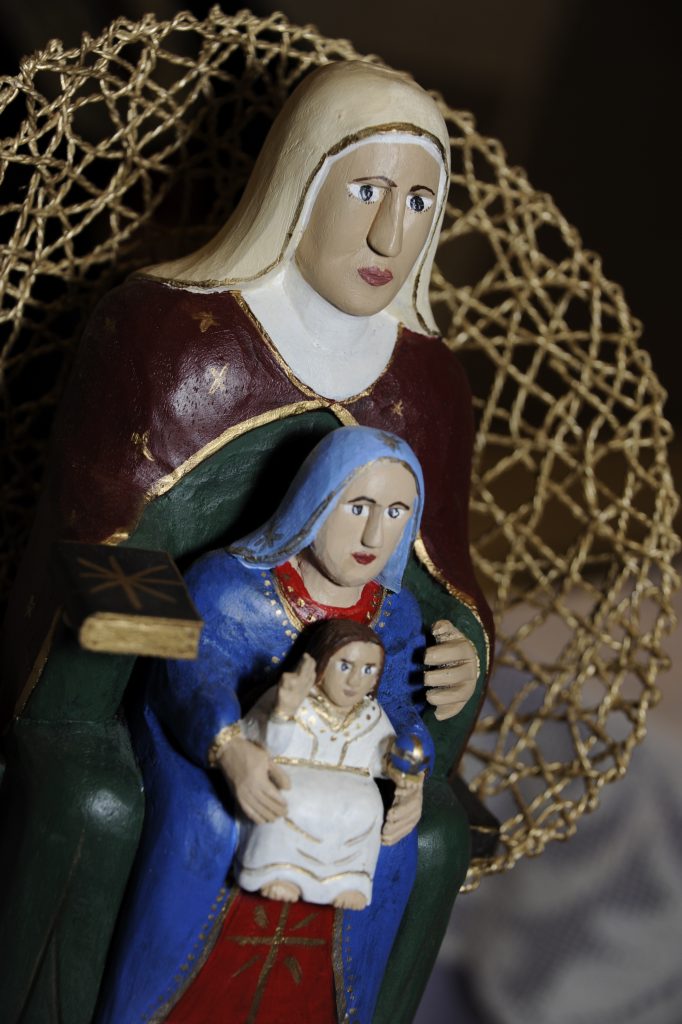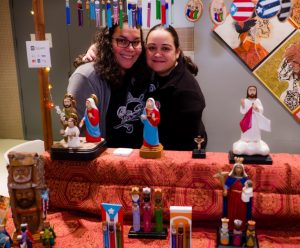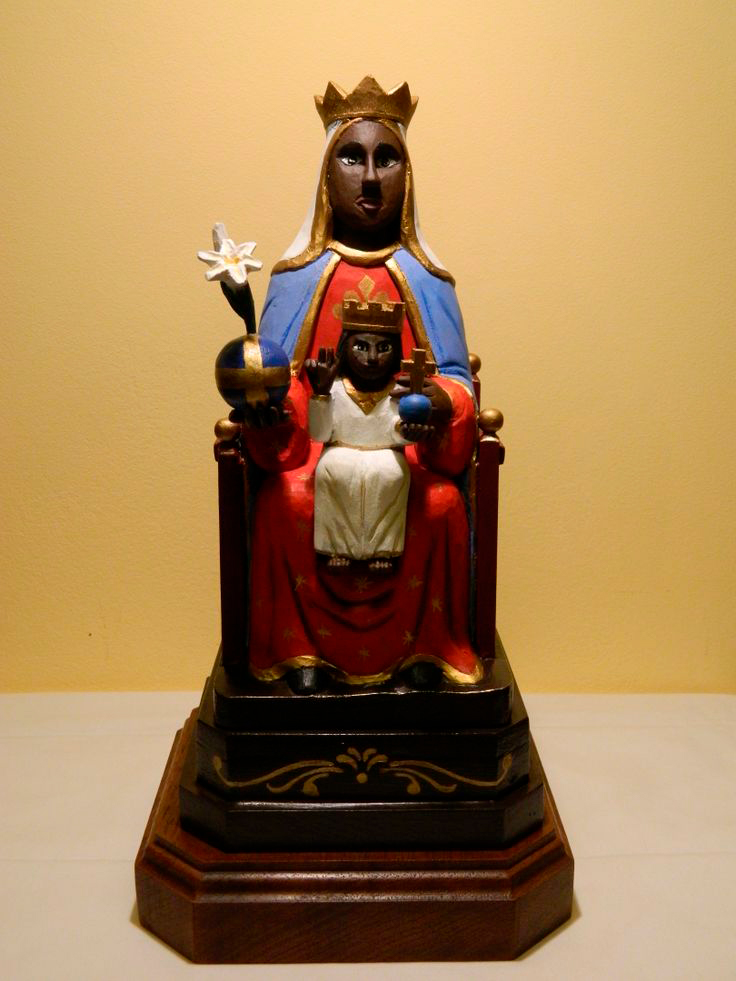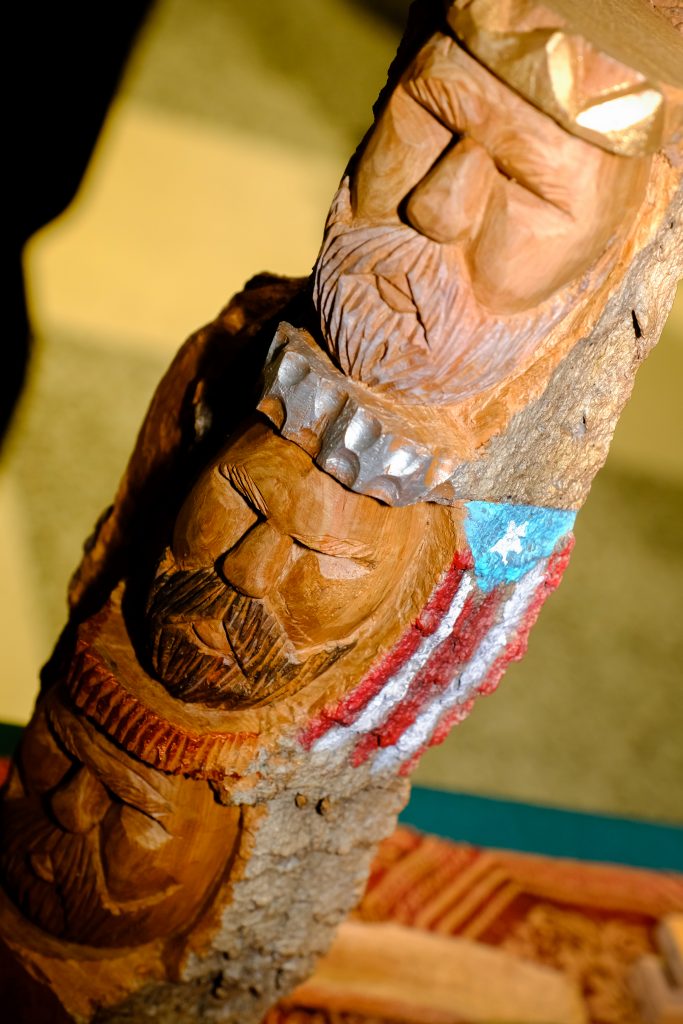By Clara Galvano Rivera
cgr.writepro@gmail.com
“I’m the first santos woodcarver (talladora) in my family,” Marta Iris Rodriguez Olmeda says with pride. Not only that, but our PRIDA Artist Everyone Should Know, is among the few female talladoras from Puerto Rico in an industry long dominated by men.

Santa Ana Triple, 2015, 15” x 10”, Statue and base Cedar wood. This piece won Honorable Mention in a contest in Puerto Rico, and it was in Aqui está El Barrio PRIDA Group exhibition in 2015.
While living and working in Cidra, her pueblo natal, Rodriguez Olmeda heard of a High School that had an adult after-school wood carving class in Cayey. Her 7-mile ride must have been interesting, given that Cayey, located on the Central Mountain Range and south of Cidra, is very mountainous. Nonetheless, her desire to learn and honor her family took root and she was introduced to her first wood carving class in 2007. Things went very well. She obtained Certifications from PRIDCO (Puerto Rico Industrial Development Company) and from the Instituto de Cultura Puertorriqueña (Institute of Puerto Rican Culture).

Marta Iris (left) with her companion and apprentice Barbara Diaz (right) at Comité Noviembre’s National Puerto Rican Artisan Fair and Book Expo at Hostos Center for the Arts and Culture in 2018.
Rodriguez Olmeda is a traditionalist. The wood she uses – cedar – has been used by generations of Puerto Rican carvers. “It’s easy to work with because it’s soft.” Carving santos carries with it a certain amount of danger. Four years ago, la cuchilla slipped and three stiches was the result. “I was carving Los Tres Reyes Magos; three stiches only, that was nothing.”
This Puerto Rican wood carver artist usually carves her santos from one single piece of wood unless the piece is very large. “When I carve, I carve from my mind. For instance, if I am carving a San Antonio, I measure and know exactly where the arms, legs, torso will be. I don’t draw the figure. As I carve, the figure reveals itself.”

Nuestra Señora de la Monserrate, 2013, 15” x 8”, the statue is made of Cedar wood, base is Mahogany wood.
Our talladora reminisces about her first creation. “Mi primera pieza fue Santa Rosa de Lima. Fue una sensación de haberlo logrado. Y los deseos de continuar creando. Durante mucho tiempo tuve mi primera pieza sin querer venderla. No fue hasta un Encuentro de Talladores en Orocovis que la vendí. Mi primera pieza la tiene uno de los mas grandes coleccionistas y colaboradores de la promoción de la Talla Puertorriqueña, el Sr. Félix Báez. El cuenta con piezas de casi todos los talladores de Puerto Rico de todos los tiempos.”
So, although Rodriguez Olmeda didn’t sell her very first piece in a commercial retail setting, the memory of the first one she did sell is still vivid in her mind. In her own words, “La primera pieza que vendí fue un set de Reyes Magos, lo recuerdo como si fuera ahora, fue en Plaza las Américas en la Feria de Santos de Plaza. y fue una sensación mixta. Fue la alegría de haber vendido una pieza pero a la vez la tristeza de dejarla ir. Aun hoy día se me salen las lágrimas cuando vendo una pieza.”

Santos Reyes Cortesa. 2017, 10” x 4”, Statue in Cottonwood Bark, Base is Mahogany wood.
The art of carving santos has been a Puerto Rican tradition since the late 15th century. Spanish missionaries used the figures of the Three Kings, Santa Barbara and San Francisco among others to spread the word of God. Santos allowed the converts to pray at home. This worked out well for those in rural areas and not near any churches. Santos and Ponce’s Vejigante masks are considered to be the oldest Puerto Rican folk arts.
According to our talladora, El Museo del Barrio, has a collection of santos, some dating from the 17th century, although none have been on exhibit for many years. Another collection of Puerto Rican santos, however, can be found in Washington D.C. and many other museums. A search of the Smithsonian collections database (collections.si.edu/search/index.htm) returned records for 148 Santos in the Art Inventories Catalog managed by the Smithsonian American Art Museum. One, a carving of Santa Rita de Casia, was carved by Felipe de la Espada, born in San Germán, ca. 1754.
Rodriguez Olmeda currently lives in The Bronx, NY. She has received too many accolades to list here, but as a member of PRIDA she participates in different art festivals and cultural activities such as Comité Noviembre’s National Puerto Rican Artisan Fair & Book Expo at Hostos Center for the Arts and Culture, Loisaida Festival, 116th Street Festival, Super Sabado at El Museo del Barrio, SOMOS Conference and many others.
Anyone buying a santos figure from Rodriguez Olmeda can feel how very special the figures are. Here is what she says about her work: “Cuando yo las tallo, las rezo, las medito y me regocijo en el proceso. Por que no tallo en producción, cada pieza es especial para mi.” A Puerto Rican treasure sharing her talents and truth is a beautiful thing indeed.
Why did she join PRIDA?
“I joined PRIDA because Puerto Rican art is important and we must make the effort to keep the heritage and traditions alive.”
Contact Marta by email at: mirolmeda@gmail.com or caminoartesanalmiro@gmail.com
Photos: ©Comité Noviembre/Ana Alicea
